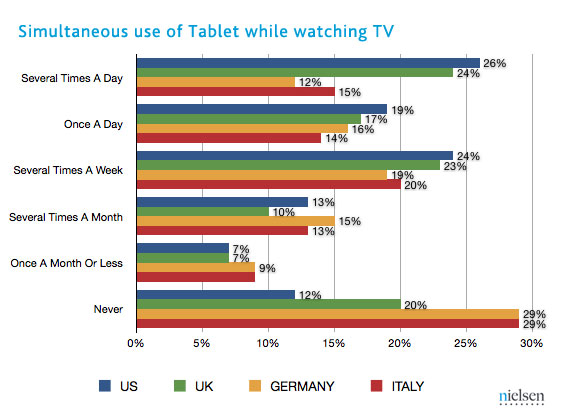TV-evolution: second screen and social TV
Continuing discussion about different eras, started in previous post, let’s now direct our attention to TV era. In the light of American President elections and Obama’s data-based victory there are a lot of comments that TV times are about to end especially in sense of using it for advertising. Customers became more clever and selective; they don’t absorb “buy it” ads, interrupting their favorite TV-shows. But they still watch TV… and chatting on Facebook or posting to Twitter or checking the news… What kind of phenomenon is that?
It is called the “second screen”. Second screen experience is the process when you use your smartphone or tablet simultaneously with watching TV, which doesn’t fully capture your attention.
According Nielsen research nearly 40% of Americans now use tablets or smartphones while watching TV at least once a day; 62% do it multiple times each week.

“Second screen” became the catalyzer, which turned passive TV-watching into shared experience, now called “social TV”. It enables viewers to go deeper into the story world, find necessary information about the product exactly when needed, share opinion, participate in discussion about what’s going on on the main screen in real time.
“Social TV” is new interesting tool, so how can it be used by marketers? Different studies suggest various combinations, let me mention some of them.
1) Engagement. Now TV viewers have another motivation to watch TV content – they can be rewarded through related Mobile apps. For example, during the basketball championship March Madness brand “Dove” Men+Care made a partnership with Viggle (the app rewarding for watching TV shows). When user was checking the broadcast, watching the game, he was re-directed to a Dove Men+Care page, where he could earn the extra points for watching Dove’s “Journey to Comfort” videos, involving basketball legend stars, such as Shaquille O’Neal.
2) TV gamifying. One more way to increase viewers involvement into TV ads absorption is to add gaming element, which is possible on the second screen. Great example is Coca-Cola’s “Chok” the app, which allowed users collect virtual bottle caps and then exchange them for digital goods, like mobile games. It worked in tight connection with the TV-commercial. Each time there was a music from Coca-Cola TV commercial, the app opened and offered users to shake a phone. Each “shake” was measured with the phones accelerometer and users were granted with the bottle caps.
3) Hashtags usage in TV commercials. By adding hashtags to TV commercial, brand can extend the commercial life beyond the main screen. It can lead to discussions in social networks and better customers’ involvement.
4) Synchronizing e-commerce with TV. Simultaneous watching and shopping was a dream for the whole history of TV commercials. Nowadays it may be possible. First steps in this direction were taken by eBay in the app “Watch With eBay”. By providing the information like zip code and cable provider and then accessing live auction, linked to what’s on the main screen, viewer is supposed to be able to purchase products, related to the movie star on the screen (Jessica Simpson brand T-shirt) or to the certain TV-show. There are still problems with algorithm of how to identify related products (now eBay app captures the whole stream and offer everything), but there is a real possibility for future.
There are many ways to extend the influence of social TV and there will be more other. So yes, traditional TV role in marketing has changed, but TV is not dying, it evolves, transforming its approach to viewers.

